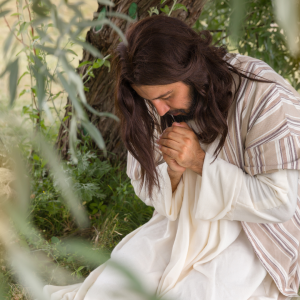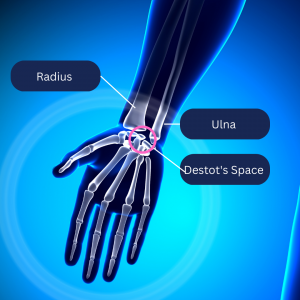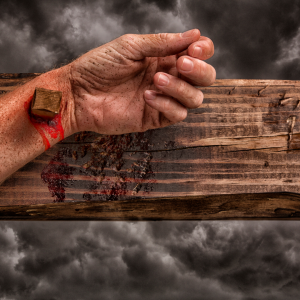The artistic renditions of Jesus crucified on the cross, are often sanitised and aestheticised – Beautifully cleaned up with strategically painted-on blood streaks at the knees or side where Jesus was pierced through with a lance, a crown of thorns neatly woven together in a braid, and more intentionally placed droplets of blood flowing down Jesus’ forehead.

Jesus, Crucified
Roman Crucifixions were designed to kill the victim, and over the centuries, the Romans in the ancient world developed ways to torture those to be crucified, while keeping them alive and prolonging their agony. Crucifixions were brutal and as a torture mechanism, are postulated to have originated from Babylon and Assyria, were deployed in the region of Persia around the 6th century B.C., were brought to the Mediterranean belt by Alexander the Great circa 4th century B.C., and were eventually introduced to the Roman Empire around the 3rd century B.C. Interestingly, crucifixion as a means of capital punishment was never deployed in pre-Hellenistic Greece. For 500 years, the Roman Empire perfected the art of crucifixion, until it was abolished by Emperor Constantine I in A.D. 4 (Retief & Cilliers, 2003). The buffet of crucified persons consisted of military defectors, criminals, political dissidents and rebels, slaves, and Christians. The victims of crucifixions, depending on the type of crucifixion and the skill of the executioner, died at an average of after 3 hours hanging on the cross, with the longest survivor hanging on for dear life for 4 days (Retief & Cilliers, 2003).
Jesus was by no means a weak man. He was a carpenter by trade, which means that he carried heavy logs, and had to saw and carve many things. These actions built strength and muscles. Jesus also spent his days walking long distances from town to town, and this built physical stamina. At the age of 33, having done all these things, he would have been in peak physical condition. However, the experience of His passion and crucifixion, would have been excruciating, even in his extraordinarily fit condition (Shrier, 2002).
While crucifixions were common, archeological evidence is left wanting, as no proper burial procedures were undertaken after the crucifixions, given the statuses of those who were crucified. During an archeological dig in the village of Fenstanton, where now Cambridgeshire, England now stands, in 2017, the skeletal remains of a man around 25 to 35 years old, and dated to having been crucified between A.D. 130 and A.D. 360 was excavated in the pre-Roman settlement area. This skeleton had a nail running through its heel bone. This was a triumph for Archaeology, for while many written reports exist about crucifixions, the world has had few physical and intact artefacts to show how these crucifixions were carried out. This find, allowed archaeologies and scientists to corroborate what they already knew. Many crucifixions also secured their victims with ropes rather than nails, and these ropes tended to disintegrate across the years. The nailing of feet was done to prevent the victims from using their feet to shift their positions of elevation as they hung in their crucified positions (British Archaeology, 2022).

Instruments of Torture that Jesus Encountered, and the Shroud of Turin
Jesus’ ordeal begins at the Garden of Gethsamane (Matthew 26:36-46, Mark 14:37-42, Luke 22:39-44) – Jesus feels such anguish that he says, “My soul is sorrowful even to death.” (Matthew 26:38) In Luke’s Gospel, it is recorded, “He was in such agony and he prayed so fervently that his sweat became like drops of blood falling on the ground.” (Luke 22:44) Modern medical diagnosis, places this phenomenon of sweating blood as Hematohidrosis – an oozing of blood from intact skin and mucus membranes. The bleeding is caused by the rupture or breaking of the dermal capillaries that feed sweat glands causing them to exude blood mixed in with sweat. This is caused by extreme physical or emotional stress (Biswas, Surana, De & Nag, 2013; Jerajani, Jaju, Phiske & Lade, 2009; Zhang, Zheng, Liu, Chen, Liu, Xu, Nie, & Hao, 2004; Holoubek & Holoubek, 1996). The occurrence of Hematohidrosis is usually painless and self-limiting, meaning it usually stops after the ordeal passes (Tshifularo, 2014; Jafar & Ahmad, 2016), however an episode can leave a person dehydrated. Having been through such emotional turmoil, it is almost ironic that Jesus is betrayed by a kiss – something that is meant to soothe and heal, but in this case is meant to incriminate and curse. As Psalm 55: 13-15 prophetically states: “For it is not an enemy that reviled me— that I could bear— Not a foe who viewed me with contempt, from that I could hide. But it was you, my other self, my comrade and friend, You, whose company I enjoyed, at whose side I walked in the house of God.”

Jesus in the Garden of Gethsemane
After the arrest of Jesus, he is brought before the Sanhedrin, where under the custody of the guards, he is mocked, spat on, and dealt blows – ‘Some began to spit on him. They blindfolded him and struck him and said to him, “Prophesy!” And the guards greeted him with blows.’ (Mark 14:65)
He is then brought before Pilate, who has him scourged in accordance to the Roman law. The ancient Romans had under their disposal, many instruments to help them achieve their aims of brutalising their victims – the catenae (chains), the habena (strap), the lorum (whip), the fustis (staff), the scutica (lash), the stimulus (goad), the virga (rod), and the flagellum or flagrum (scourge) (Nicolotti, 2018). Of the flagellum, there were various prototypes – some had bones tied along the entire length of the tails, some had bones only tied to the ends, some were held together by rods, others by rings, and some had attached lead balls/nuggets to the ends of the tails. While popular opinions hold that the flagellum that was used had sharp spikes attached to the tails, and that which ripped out Jesus’ flesh during the scourging, this would have resulted in the intensity of such blood loss, that He would have died on the way to the Crucifixion, and not at the Crucifixion itself. As the Romans’ aim was to have Jesus utterly humiliated on the cross, it is likely that the flagellum that they used was the one featuring the lead balls (Holoubek & Holoubek, 1996). This would have been a deliberate choice, as the whipping from such a flagellum would result in immense bruising, and terrible pain but maintain the skin structure enough, so as to prevent excessive blood loss.

The Scourging of Jesus
From the Gospel accounts (John 19:2; Mark 15:17; Matthew 27:29), we read that the Roman soldiers in an attempt to mock Jesus, gather up thorns from the vicinity – likely the Jerusalem Thorn, or as it is known by its Scientific name – Paliurus spina-christi, and trust these onto Jesus’ head. It is highly unplausible that these Roman Soldiers would bother weaving the thorns into the neat circlet around Jesus’ head we often see depicted in artistic renditions, and the more credulous train of action, would be for the Roman soldiers to simply gather various thorn vines, push (weave) them together, and dump the clump of thorns on his head.

The Crowning of Thorns
We must remember that since the last meal of the Passover that Jesus shared with his disciples, he has not had any food, nor drink, nor sleep since his arrest. The physical blows, and the various torture received, would have also weakened Jesus significantly.

Carrying the Crossbeam of the Cross
Jesus then carried the cross about 600 metres from where he was sentenced to its end point at Golgotha. While art depictions show Jesus carrying the full-T of the cross, the reality is that the cross was usually separated into two parts. The vertical part – the stipes, was found usually already permanently affixed at the site of the crucifixion outside the city walls. There would usually be hundreds of these. Josephus (1936) writes that during Titus’ siege of Jerusalem, up to 500 people could be crucified in a day. What Jesus would have done, was to carry the cross-beam (the horizontal element of the cross) called the patibulum across his shoulders and on his back, with his arms tied to it. At the site of the crucifixion, the soldiers would stretch the arms out and if they were using nails, would locate the pre-existing indentations on the patibulum, and hammer the nails in. Sometimes, if the person’s arms were not long enough, they would dislocate the shoulder of the person to stretch the person’s arm exactly over the spot where it was to be nailed down. Artistic renderings of the crucifixions usually show the nails in the centre of each palm, situating the nail among the metacarpal bones of the hand, but because there are no ligaments between these bones that are strong enough to hold up the weight of the body, while it lay vertically against the cross in this region of the hand, the hand tissues would tear and the body will fall down (Papaloucas, Georgiou, Pistevou-Gompaki, 2011).
It would be more anatomically correct for the nail/spike to enter through the wrist, through the space between the Radius and Ulna bones of the forearm. Pierre Barbet (1953) a medical doctor carried out a series of experiments on corpses and showed that regardless of which part of the wrist the nail was pierced, once it had passed through the soft parts of the wrist and had penetrated fully into the wrist, it was automatically guided in such a way that it emerged through the skin at the back of the wrist, approximately about 1cm above the point of entry, passing through the Destot’s space without fracturing any of the bones surrounding it (See figure below)

Anatomical placement of where the nail would have been hammered into Jesus.
To have the nail pierce through the wrist, would damage the Median nerve, the Ulnar nerve, and the Radial nerve, and cause the person searing pain, especially when the weight was utterly supported on those points, and when the victim shifted his weight on his wrists in an attempt to breathe.

Jesus nailed to the Cross
The patibulum would then be hoisted up to the vertical beam, after the nailing was complete, and the crucified person would sag down taken over by gravity, with his weight bearing down on the nail points. The feet would then be nailed to the stipes. Those who were crucified would struggle to breathe, as the position would render the thoracic muscles unable to move, with the diaphragm pulling down and unable to reset. As such, the victim would have to hoist himself up on his nail-points so as to intake and exhale a breath. In this position, the muscles of the person especially the Deltoids, the Trapezium, the quadriceps and hamstrings, and the arms are simultaneously cramping and spasming as the body produces lactic acid, and as the body dehydrates further. The person finally dies in spastic contraction under the condition of asphyxiation, and the further factors of trauma and shock (Marslen & Mitchell, 2006; van Wingerden, 2020; Byard, 2016; Habermas, Kopel, & Shaw, 2021; Bergeron, 2012).
To hasten the death, the legs of the victim would be broken, so as to prevent the victim from straightening his legs, so as to push himself up to obtain a breath. Death usually arrived within minutes after the legs were broken (Holoubek & Holoubek, 1995). When the soldiers came around to Jesus, he was already dead, and so they did not have to break his legs. Longinus, pierced Jesus’s side to check if he were really dead. While the Ancient Romans did not know it at that time, the presence of “blood” and water” is a natural process of death. Jesus had a haemothorax resulting from a collection of blood in the space between the chest wall and the lung, likely from the severe flagellation. When the body dies, and the blood is no longer circulating around the body, the blood separates into layers, with the denser red blood cells (the blood)descending to the bottom, and the light plasma (water) rising above that layer. The withdrawal of the spear would see first, the flowing out of the red blood cells, then the plasma, the water (Hattrup, 2019).
What do you see when you behold Jesus on the Cross? Do you see the love of God poured out for humanity, or do you see weakness?
Isaiah 53:1-6
“Who would believe what we have heard?
To whom has the arm of the LORD been revealed?
He grew up like a sapling before him,
like a shoot from the parched earth;
He had no majestic bearing to catch our eye,
no beauty to draw us to him.
He was spurned and avoided by men,
a man of suffering, knowing pain,
Like one from whom you turn your face,
spurned, and we held him in no esteem.
Yet it was our pain that he bore,
our sufferings he endured.
We thought of him as stricken,
struck down by God and afflicted,
But he was pierced for our sins,
crushed for our iniquity.
He bore the punishment that makes us whole,
by his wounds we were healed.
We had all gone astray like sheep,
all following our own way;
But the LORD laid upon him
the guilt of us all.”
By the Grace of God,
Brian Bartholomew Tan
(Images created on Canva)
References
Barbet, P. (1953). A Doctor at Calvary. New York: P.J. Kenedy & Sons.
Bergeron J. W. (2012). The crucifixion of Jesus: review of hypothesized mechanisms of death and implications of shock and trauma-induced coagulopathy. Journal of forensic and legal medicine, 19(3), 113–116. https://doi.org/10.1016/j.jflm.2011.06.001
Biswas, S., Surana, T., De, A., & Nag, F. (2013). A curious case of sweating blood. Indian journal of dermatology, 58(6), 478–480. https://doi.org/10.4103/0019-5154.119964
British Archaeology. (2022). Crucifixion in the Fens: life & death in Roman Fenstanton. British Archaeology. Council for British Archaeology. Retrieved March 16, 2023 from https://www.archaeologyuk.org/resource/free-access-to-crucifixion-in-the-fens-life-and-death-in-roman-fenstanton.html
Byard R. W. (2016). Forensic and historical aspects of crucifixion. Forensic science, medicine, and pathology, 12(2), 206–208. https://doi.org/10.1007/s12024-016-9758-0
Habermas, G., Kopel, J., & Shaw, B. C. F. (2021). Medical views on the death by crucifixion of Jesus Christ. Proceedings (Baylor University. Medical Center), 34(6), 748–752. https://doi.org/10.1080/08998280.2021.1951096
Hattrap, K. (2019). A doctor on why “blood and water” gushed from Jesus’ heart. Aleteia. Retrieved March 16, 2023 from https://aleteia.org/2019/06/22/a-doctor-on-why-blood-and-water-gushed-from-jesus-heart/
Holoubek, J. E., & Holoubek, A. B. (1995). Execution by crucifixion. History, methods and cause of death. Journal of medicine, 26(1-2), 1–16.
Holoubek, J. E., & Holoubek, A. B. (1996). Blood, sweat and fear. “A classification of hematidrosis”. Journal of medicine, 27(3-4), 115–133.
Jafar, A., & Ahmad, A. (2016). Child Who Presented with Facial Hematohidrosis Compared with Published Cases. Case reports in dermatological medicine, 2016, 5095781. https://doi.org/10.1155/2016/5095781
Jerajani, H. R., Jaju, B., Phiske, M. M., & Lade, N. (2009). Hematohidrosis – a rare clinical phenomenon. Indian journal of dermatology, 54(3), 290–292. https://doi.org/10.4103/0019-5154.55645
Josephus, A. (1936). The Life and Works of Flavius Josephus. Trans. Whinston, W. Porter, A.M. & Coates, P. J.C. Winston.
Maslen, M. W., & Mitchell, P. D. (2006). Medical theories on the cause of death in crucifixion. Journal of the Royal Society of Medicine, 99(4), 185–188. https://doi.org/10.1177/014107680609900416
Nicolotti,A. (2018). What do we Know about the Scourging of Jesus? The Ancient Near East Today. Friends of Asor, VI (12). Retrieved March 16, 2023 from https://www.asor.org/anetoday/2018/12/What-Do-We-Know-About-Scourging-Jesus/
Papaloucas, C., Georgiou, M., & Pistevou-Gompaki, K. (2011). The correct anatomical representation of the crucifixion of Jesus proof via anatomical data. Aristotle University of Thessaloniki. Retrieved March 16, 2023, from oai:ejournals.lib.auth.gr:article/4689
Retief, F. P., & Cilliers, L. (2003). The history and pathology of crucifixion. South African medical journal = Suid-Afrikaanse tydskrif vir geneeskunde, 93(12), 938–941.
Shrier, C. (2002). The Science of the Crucifixion. Azusa Pacific University. Retrieved March 16, 2023 from https://www.apu.edu/articles/the-science-of-the-crucifixion/
Tshifularo M. (2014). Blood otorrhea: blood stained sweaty ear discharges: hematohidrosis; four case series (2001-2013). American journal of otolaryngology, 35(2), 271–273. https://doi.org/10.1016/j.amjoto.2013.09.006
van Wingerden R. (2020). Crucifixion misconceptions in medicine studies. Forensic science, medicine, and pathology, 16(3), 565–566. https://doi.org/10.1007/s12024-020-00239-y
Zhang, F. K., Zheng, Y. L., Liu, J. H., Chen, H. S., Liu, S. H., Xu, M. Q., Nie, N., & Hao, Y. S. (2004). Zhonghua xue ye xue za zhi = Zhonghua xueyexue zazhi, 25(3), 147–150.

